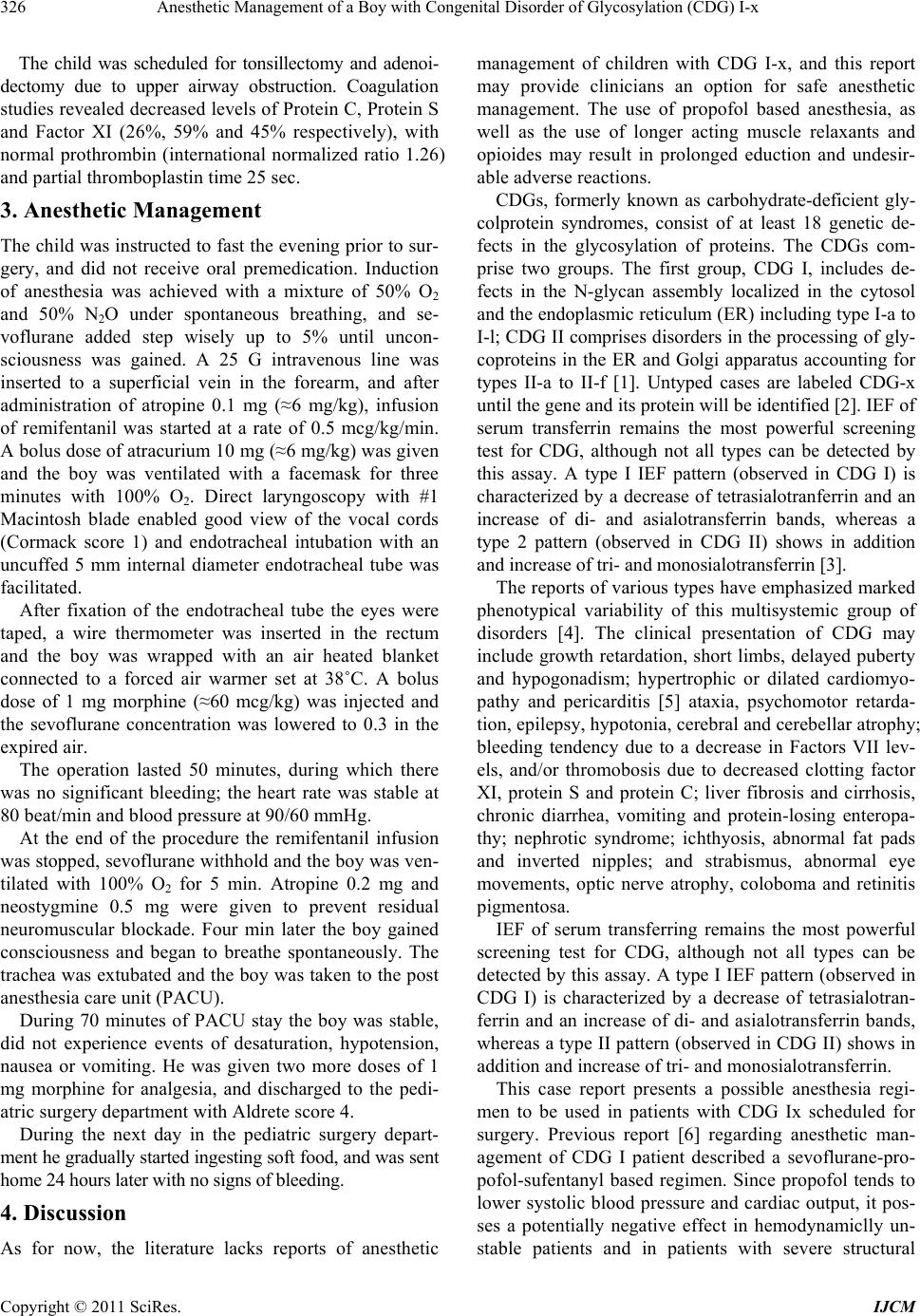
Anesthetic Management of a Boy with Congenital Disorder of Glycosylation (CDG) I-x
326
The child was scheduled for tonsillectomy and adenoi-
dectomy due to upper airway obstruction. Coagulation
studies revealed decreased levels of Protein C, Protein S
and Factor XI (26%, 59% and 45% respectively), with
normal prothrombin (international normalized ratio 1.26)
and partial thromboplastin time 25 sec.
3. Anesthetic Management
The child was instructed to fast the evening prior to sur-
gery, and did not receive oral premedication. Induction
of anesthesia was achieved with a mixture of 50% O2
and 50% N2O under spontaneous breathing, and se-
voflurane added step wisely up to 5% until uncon-
sciousness was gained. A 25 G intravenous line was
inserted to a superficial vein in the forearm, and after
administration of atropine 0.1 mg (≈6 mg/kg), infusion
of remifentanil was started at a rate of 0.5 mcg/kg/min.
A bolus dose of atracurium 10 mg (≈6 mg/kg) was given
and the boy was ventilated with a facemask for three
minutes with 100% O2. Direct laryngoscopy with #1
Macintosh blade enabled good view of the vocal cords
(Cormack score 1) and endotracheal intubation with an
uncuffed 5 mm internal diameter endotracheal tube was
facilitated.
After fixation of the endotracheal tube the eyes were
taped, a wire thermometer was inserted in the rectum
and the boy was wrapped with an air heated blanket
connected to a forced air warmer set at 38˚C. A bolus
dose of 1 mg morphine (≈60 mcg/kg) was injected and
the sevoflurane concentration was lowered to 0.3 in the
expired air.
The operation lasted 50 minutes, during which there
was no significant bleeding; the heart rate was stable at
80 beat/min and blood pressure at 90/60 mmHg.
At the end of the procedure the remifentanil infusion
was stopped, sevoflurane withhold and the boy was ven-
tilated with 100% O2 for 5 min. Atropine 0.2 mg and
neostygmine 0.5 mg were given to prevent residual
neuromuscular blockade. Four min later the boy gained
consciousness and began to breathe spontaneously. The
trachea was extubated and the boy was taken to the post
anesthesia care unit (PACU).
During 70 minutes of PACU stay the boy was stable,
did not experience events of desaturation, hypotension,
nausea or vomiting. He was given two more doses of 1
mg morphine for analgesia, and discharged to the pedi-
atric surgery department with Aldrete score 4.
During the next day in the pediatric surgery depart-
ment he gradually started ingesting soft food, and was sent
home 24 hours later with no signs of bleeding.
4. Discussion
As for now, the literature lacks reports of anesthetic
management of children with CDG I-x, and this report
may provide clinicians an option for safe anesthetic
management. The use of propofol based anesthesia, as
well as the use of longer acting muscle relaxants and
opioides may result in prolonged eduction and undesir-
able adverse reactions.
CDGs, formerly known as carbohydrate-deficient gly-
colprotein syndromes, consist of at least 18 genetic de-
fects in the glycosylation of proteins. The CDGs com-
prise two groups. The first group, CDG I, includes de-
fects in the N-glycan assembly localized in the cytosol
and the endoplasmic reticulum (ER) including type I-a to
I-l; CDG II comprises disorders in the processing of gly-
coproteins in the ER and Golgi apparatus accounting for
types II-a to II-f [1]. Untyped cases are labeled CDG-x
until the gene and its protein will be identified [2]. IEF of
serum transferrin remains the most powerful screening
test for CDG, although not all types can be detected by
this assay. A type I IEF pattern (observed in CDG I) is
characterized by a decrease of tetrasialotranferrin and an
increase of di- and asialotransferrin bands, whereas a
type 2 pattern (observed in CDG II) shows in addition
and increase of tri- and monosialotransferrin [3].
The reports of various types have emphasized marked
phenotypical variability of this multisystemic group of
disorders [4]. The clinical presentation of CDG may
include growth retardation, short limbs, delayed puberty
and hypogonadism; hypertrophic or dilated cardiomyo-
pathy and pericarditis [5] ataxia, psychomotor retarda-
tion, epilepsy, hypotonia, cerebral and cerebellar atrophy;
bleeding tendency due to a decrease in Factors VII lev-
els, and/or thromobosis due to decreased clotting factor
XI, protein S and protein C; liver fibrosis and cirrhosis,
chronic diarrhea, vomiting and protein-losing enteropa-
thy; nephrotic syndrome; ichthyosis, abnormal fat pads
and inverted nipples; and strabismus, abnormal eye
movements, optic nerve atrophy, coloboma and retinitis
pigmentosa.
IEF of serum transferring remains the most powerful
screening test for CDG, although not all types can be
detected by this assay. A type I IEF pattern (observed in
CDG I) is characterized by a decrease of tetrasialotran-
ferrin and an increase of di- and asialotransferrin bands,
whereas a type II pattern (observed in CDG II) shows in
addition and increase of tri- and monosialotransferrin.
This case report presents a possible anesthesia regi-
men to be used in patients with CDG Ix scheduled for
surgery. Previous report [6] regarding anesthetic man-
agement of CDG I patient described a sevoflurane-pro-
pofol-sufentanyl based regimen. Since propofol tends to
lower systolic blood pressure and cardiac output, it pos-
ses a potentially negative effect in hemodynamiclly un-
stable patients and in patients with severe structural
Copyright © 2011 SciRes. IJCM